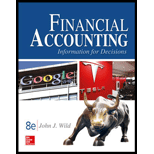
Concept explainers
1.
Concept Introduction:
Accounting has a formula that represents assets is equal to the liabilities plus owner’s equity. Each year owner’s equity is calculated by after reducing and adding the profit or loss of the year. Net Income or profit is calculated by reducing expenses from revenues.
To Calculate: Equity at year end.
2.
Concept Introduction:
Accounting has formula that represents assets is equal to the liabilities plus owner’s equity. Each year owner’s equity is calculated by after reducing and adding the profit or loss of the year. Net Income or profit is calculated by reducing expenses from revenues.
To Calculate: Equity at year-end.
3.
Concept Introduction:
Accounting has formula that represents assets is equal to the liabilities plus owner’s equity. Each year owner’s equity is calculated by after reducing and adding the profit or loss of the year. Net Income or profit is calculated by reducing expenses from revenues.
To Calculate: Equity at year-end and beginning.
Want to see the full answer?
Check out a sample textbook solution
Chapter 1 Solutions
Financial Accounting: Information for Decisions
- I am looking for the correct answer to this general accounting problem using valid accounting standards.arrow_forwardPlease given correct answer for General accounting question I need step by step explanationarrow_forwardPlease explain the solution to this financial accounting problem with accurate principles.arrow_forward
- General accountingarrow_forwardHello tutor please given General accounting question answer do fast and properly explain all answerarrow_forwardChalmers Corporation operates in multiple areas of the globe, and relatively large price changes are common. Presently, the company sells 110,200 units for $50 per unit. The variable production costs are $20, and fixed costs amount to $2,079,500. Production engineers have advised management that they expect unit labor costs to rise by 10 percent and unit materials costs to rise by 15 percent in the coming year. Of the $20 variable costs, 25 percent are from labor and 50 percent are from materials. Variable overhead costs are expected to increase by 20 percent. Sales prices cannot increase more than 12 percent. It is also expected that fixed costs will rise by 10 percent as a result of increased taxes and other miscellaneous fixed charges. The company wishes to maintain the same level of profit in real dollar terms. It is expected that to accomplish this objective, profits must increase by 8 percent during the year. Required: Compute the volume in units and the dollar sales level…arrow_forward
 Managerial Accounting: The Cornerstone of Busines...AccountingISBN:9781337115773Author:Maryanne M. Mowen, Don R. Hansen, Dan L. HeitgerPublisher:Cengage Learning
Managerial Accounting: The Cornerstone of Busines...AccountingISBN:9781337115773Author:Maryanne M. Mowen, Don R. Hansen, Dan L. HeitgerPublisher:Cengage Learning Financial AccountingAccountingISBN:9781305088436Author:Carl Warren, Jim Reeve, Jonathan DuchacPublisher:Cengage Learning
Financial AccountingAccountingISBN:9781305088436Author:Carl Warren, Jim Reeve, Jonathan DuchacPublisher:Cengage Learning Financial AccountingAccountingISBN:9781337272124Author:Carl Warren, James M. Reeve, Jonathan DuchacPublisher:Cengage Learning
Financial AccountingAccountingISBN:9781337272124Author:Carl Warren, James M. Reeve, Jonathan DuchacPublisher:Cengage Learning


